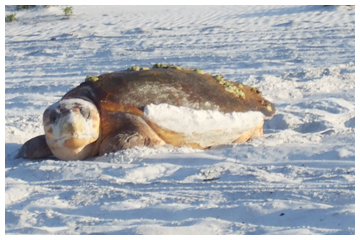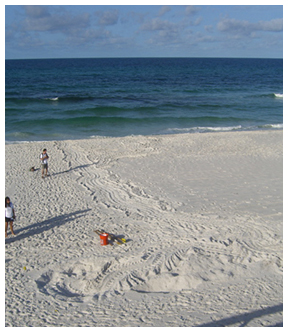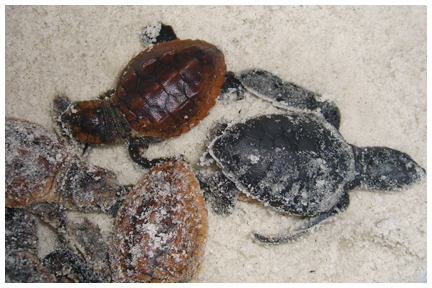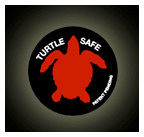South Walton Turtle Watch Group
keeps track of South Walton nesting sea turtles

South Walton turtle nest season runs May 1 – October 31
According to Florida Fish and Wildlife Conservation Commission, sea turtles, are among the oldest creatures on earth, and have remained essentially unchanged for 110 million years.
However, they face an uncertain future. Illegal harvesting, habitat encroachment, and pollution (physical and light) are only some of the things sea turtles must face as each species struggles to stay alive.
We are fortunate to have a local group of dedicated volunteers, South Walton Turtle Watch, who monitor our beaches on a daily basis during the turtle season.
Led by Sharon Maxwell, the group was formed in 1995. There are more than 70 members, 25 of which have state-issued permits. The volunteers walk the beach in the early morning hours, and have a designated area each monitors for turtle tracks and nests.

It is a complicated process once a nest is discovered. First, it must be determined that it is a true nest and not a false crawl. The tracks are measured and it is determined by the size and markings what type of turtle it is. If a nest is too close to the tide line, it must be moved to prevent the drowning of the eggs. Then there is a barricade constructed to mark off and protect the nest. And it is all done before 9 a.m.
The group continues to monitor each nest until the hatchlings emerge and head into the Gulf of Mexico.
“We, as sea turtle volunteers, go through many hours of training so that we may help these wonderful sea turtles. We are learning more each year. That is why we can get sea turtle permits, which allows us to help the endangered and threatened animals,” Maxwell said.
With each attempted nesting, the turtles face an uphill battle. Problems with visitors erecting tents and digging holes, creates confusion for the female attempting to nest, or in some instances, death if she falls into a hole dug by a careless visitor.
From Florida Fish and Wildlife Conservation Commission:
Each year from May 1 – October 31, there are four species of Florida sea turtles that nest along the beach in South Walton County – Loggerhead, Green, Leatherback and on occasion, Kemp’s Ridley.
For more information on sea turtles go to:www.myfwc.com/research/wildlife/sea-turtles/fl-sea-turtles/species

Sea turtles are protected by the Endangered Species Act, and only those with special permits are allowed to touch the nests, turtles, or hatchlings. There is a $2,500.00 reward for information leading to the conviction of violators. To report a violation, contact a State, Federal, or local law enforcement officer.
It is illegal to harm, harass or kill any sea turtles, their eggs, or hatchlings. If you find hatchlings wandering in a road, parking lot, or in a direction other than toward the water, call the Florida Fish and Wildlife Conservation Commission at (888) 404-FWCC or *FWC from your mobile phone.
How can you help nesting sea turtles?
If you see a sea turtle, it is important to stay out of the sea turtle’s way. Do not put your hands on or near the turtle. Any distractions may frighten or disorient the turtle, causing a female to return to the ocean before finishing her nest.
If you own beach-front property, please remove obstacles on the beach which may impede the slow travel of these huge animals as they make their way up to the dune line to nest. Remove beach chairs, tables, water-sport items and any other obstacles. After nesting, be considerate of the hatchlings and make sure that they have a path to the water when it is time for them to hatch.
A lot of people like to dig holes in the sand. These are fine during the day but may pose additional hazards at night. Please refill these holes so that sea turtles and hatchlings do not get caught on their way to nest or to the water.
Keep waterways clean by properly throwing away any trash, plastic or beach gear that you no longer want. Debris that blows into or is drawn into the water by the tides causes potential hazards for marine life. Some of the plastics may be mistaken for jelly fish, which some sea turtles eat. Other items may entangle animals if they swim through any holes in the debris or get items wrapped around flippers, tails or wings. Practice conservation efforts by cleaning up the beach or a waterway any time you visit—all wildlife will benefit from this service.
What do you do if you see hatchlings on the beach or disoriented hatchlings heading away from the beach?
Hatchlings must overcome many obstacles in their natural habitat to successfully reach adulthood. After hatching, they must dig out of their nest, a process that may take a few days. Once out, predators feed on them, and any misdirection may leave them lost and, soon, dehydrated by the morning sun. Enjoy the experience from a distance. Do not make it any more difficult for sea turtles to survive. Please do not “help” them to the water—they need to make the trek on their own.
If you come across a hatchling that is wandering in a road, parking lot; or in a direction other than the water call the Florida Fish and Wildlife Conservation Commission (FWC) Resource Alert numbers at 1-888-404-FWCC (3922) or *FWC from your cell phone.
For more information about sharing the beach with nesting turtles and hatchlings go to:
www.myfwc.com/research/wildlife/sea-turtles/fl-sea-turtles/contact
The South Walton Turtle Watch needs walkers for the upcoming Sea Turtle Season, which begins in May. Walkers are asked to commit to one day a week in the area of your choice. Training is being done on April 8 in Panama City Beach and also by area coordinators. Turtle watch is responsible for all non state park beach areas in Walton County. For more information please contact Sharon Maxwell (850) 897-5228 or email: swturtlewh@cox.net.
For more information about our local sea turtles visit: www.seaturtlewatch.com

A local company has created innovative flashlight filters to help protect the turtles from distracting light. Check out the company’s website at: http://turtlesafeproducts.com
– – – – – – – – – –
Click here to read story about loggerhead laying eggs in broad daylight!
– – – – – – – – – –
Click here to read story about two rehabilitated turtles released into Gulf
– – – – – – – – – –

2 Comments
Comments are closed.